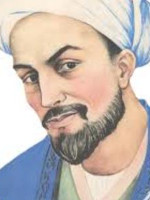Saadi Shirazi
Biography of Saadi Shirazi

Saadi was born in Shiraz, Iran, according to some, shortly after 1200, according to others sometime between 1213 and 1219. In the Golestan, composed in 1258, he says in lines evidently addressed to himself, "O you who have lived fifty years and are still asleep"; another piece of evidence is that in one of his qasida poems he writes that he left home for foreign lands when the Mongols came to his homeland Fars, an event which occurred in 1225. Saadi was a Sunni Muslim. According to Annemarie Schimmel the tendency of Shia to associate with the Sunni poet became the norm after Twelver Shiaism became the state religion of the Safavid Empire.
Saadi Shirazi whose family were from religious scholars, lost his father when he was a child. Then he was under the guardianship of his maternal grandmother. He narrates memories of going out with his father as a child during festivities.
After leaving Shiraz he enrolled at the Nizamiyya University in Baghdad, where he studied Islamic sciences, law, governance, history, Persian literature, and Islamic theology; it appears that he had a scholarship to study there. In the Golestan, he tells us that he studied under the scholar Abu'l-Faraj ibn al-Jawzi (presumably the younger of two scholars of that name, who died in 1238).
In the Bustan and Golestan Saadi tells many colourful anecdotes of his travels, although some of these, such as his supposed visit to the remote eastern city of Kashgar in 1213, may be fictional. The unsettled conditions following the Mongol invasion of Khwarezm and Iran led him to wander for thirty years abroad through Anatolia (where he visited the Port of Adana and near Konya met ghazi landlords), Syria (where he mentions the famine in Damascus), Egypt (where he describes its music, bazaars, clerics and elites), and Iraq (where he visits the port of Basra and the Tigris river). In his writings he mentions the qadis, muftis of Al-Azhar, the grand bazaar, music and art. At Halab, Saadi joins a group of Sufis who had fought arduous battles against the Crusaders. Saadi was captured by Crusaders at Acre where he spent seven years as a slave digging trenches outside its fortress. He was later released after the Mamluks paid ransom for Muslim prisoners being held in Crusader dungeons.
Saadi visited Jerusalem and then set out on a pilgrimage to Mecca and Medina. It is believed that he may have also visited Oman and other lands in the south of the Arabian Peninsula.
Because of the Mongol invasions he was forced to live in desolate areas and met caravans fearing for their lives on once-lively silk trade routes. Saadi lived in isolated refugee camps where he met bandits, Imams, men who formerly owned great wealth or commanded armies, intellectuals, and ordinary people. While Mongol and European sources (such as Marco Polo) gravitated to the potentates and courtly life of Ilkhanate rule, Saadi mingled with the ordinary survivors of the war-torn region. He sat in remote tea houses late into the night and exchanged views with merchants, farmers, preachers, wayfarers, thieves, and Sufi mendicants. For twenty years or more, he continued the same schedule of preaching, advising, and learning, honing his sermons to reflect the wisdom and foibles of his people. Saadi's works reflect upon the lives of ordinary Iranians suffering displacement, agony and conflict during the turbulent times of the Mongol invasion.
Saadi mentions honey-gatherers in Azarbaijan, fearful of Mongol plunder. He finally returns to Persia where he meets his childhood companions in Isfahan and other cities. At Khorasan Saadi befriends a Turkic Emir named Tughral. Saadi joins him and his men on their journey to Sindh where he meets Pir Puttur, a follower of the Persian Sufi grand master Shaikh Usman Marvandvi (1117–1274).
He also refers in his writings about his travels with a Turkic Amir named Tughral in Sindh (Pakistan across the Indus and Thar), India (especially Somnath, where he encounters Brahmans), and Central Asia (where he meets the survivors of the Mongol invasion in Khwarezm). Tughral hires Hindu sentinels. Tughral later enters service of the wealthy Delhi Sultanate, and Saadi is invited to Delhi and later visits the Vizier of Gujarat. During his stay in Gujarat, Saadi learns more about the Hindus and visits the large temple of Somnath, from which he flees due to an unpleasant encounter with the Brahmans. Katouzian calls this story "almost certainly fictitious".
Saadi came back to Shiraz before 1257 CE / 655 AH (the year he finished composition of his Bustan). Saadi mourned in his poetry the fall of Abbasid Caliphate and Baghdad's destruction by Mongol invaders led by Hulagu in February 1258.
When he reappeared in his native Shiraz, he might have been in his late forties. Shiraz, under Atabak Abubakr ibn Sa'd ibn Zangi (1231–60), the Salghurid ruler of Fars, was enjoying an era of relative tranquility. Saadi was not only welcomed to the city but was shown great respect by the ruler and held to be among the greats of the province. Some scholars believe that Saadi took his nom de plume (in Persian takhallos) from the name of Abubakr's son, Sa'd, to whom he dedicated the Golestan; however, Katouzian argues that it is likely that Saadi had already taken the name from Abubakr's father Sa'd ibn Zangi (d. 1226). Some of Saadi's most famous panegyrics were composed as a gesture of gratitude in praise of the ruling house and placed at the beginning of his Bustan. The remainder of Saadi's life seems to have been spent in Shiraz.
The traditional date for Saadi's death is between 1291 and 1294.